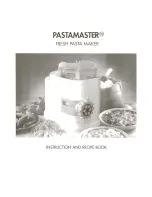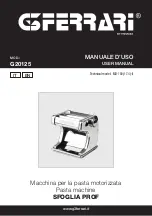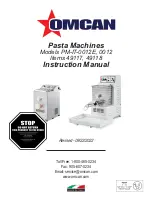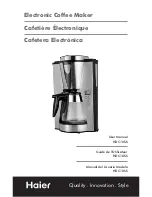
ENGLISH
- 9 -
1.
IMPORTANT: Before you begin, make sure the slide gate is in the fully closed, (mix)
position.
2.
Choose the die for the shape of pasta you desire.
3.
Place the die in a small bowl of very hot water. Add several drops of olive or vegetable
oil to the water. Ensure the water covers the die. Let sit for 1 or 2 minutes.
4.
Place the die, aligning the notches on the die with the ridges on the extrusion chamber,
and hand tighten the lock nut in place. NOTE: Check to ensure lock nut is snug against
extrusion chamber.
5.
Add appropriate amount of flour, per the recipe you choose. Always measure the flour
carefully. Spoon flour into the PASTA MAKER dry measuring cup and level off with a
blunt knife. Do not pack down.
6.
Pour measured flour into mixing bowl assembly. Place mixing bowl lid on the mixing
bowl. It will fasten with a snap when properly aligned.
7.
Turn the machine on and let run for 30 seconds.
8.
Fill your PASTA MAKER liquid measuring cup to the appropriate black line with very
warm water, add 1 Tablespoon of oil (olive or vegetable). If your recipe calls for eggs,
break 2 eggs into your PASTA MAKER measuring cup (beat thoroughly). Add 1
Tablespoon of oil (olive or vegetable). Fill your PASTA MAKER measuring cup to the
appropriate Black line with very warm water.
9.
SLOWLY ADD THE LIQUID from your recipe thorough the specially designed slots in the
mixing bowl lid. Do not add all the liquid. Hold about 10% in reserve. You may find you
need to add it later to correct dough that is to dry.
NOTE: Your pasta mixture will not blend correct if you add liquid too fast.
10.
After adding all but about 20% of the liquid, allow the machine to mix for 3 minutes.
11.
Stop the machine after 3 minutes, open the lid and examine the dough. The proper
consistency is small, pea-sized lumps, similar in appearance to small cottage cheese
curds. You should be able to pinch a small amount of dough between your fingers and
form a ball. If you find the dough is to grainly, (looks similar to sand or corn meal),
turn machine on and add about ½ of the remaining liquid.
12.
Allow the machine to mix for another minute.
13.
Stop the machine to examine the dough, if it has now formed large lumps of dough
that are sticky to the touch, it is too wet. Turn machine on and add 1 tablespoon of
flour to the dough. Allow machine to mix for another minute.
14.
Once dough has reached the proper consistency and you are ready to extrude, gently
pull open the slide gate to the extrude position.
15.
The machine should start extruding the pasta within about minute. You will notice the
motor sound will change as it starts extruding. This is normal.
NOTE: If you hear loud popping noises or see the unit under heavy strain,
IMMEDIATELY TURN THE MACHINE OFF. Refer to troubleshooting tips.
16.
When you have extruded about 1 inch pasta, cut it off with the enclosed knife and
discard.
17.
Continue extruding. Cutting pasta to desired length with the enclosed knife.
18.
You may notice after you have extruded for a few minutes, the pasta slowing down. If
this happens, push slide gate in until it stops, (Mix position, then pull open to extrude
position).
19.
You may find you need to stop the machine at times during extruding and remove any
dough that has built up on the mixing blades or in the corners of the mixing bowl. You
can also check the slide gate opening at the bottom of the mixing bowl and clear any
dough that might build up around the opening.
20.
Once all the dough has been cleared from the mixing bowl, continue to allow the pasta
to extrude for several minutes, then turn the machine off.
Attention: The pasta maker must be working after turn on the on/off switch, then turn
on the PCB panel’s on/off switch.










































